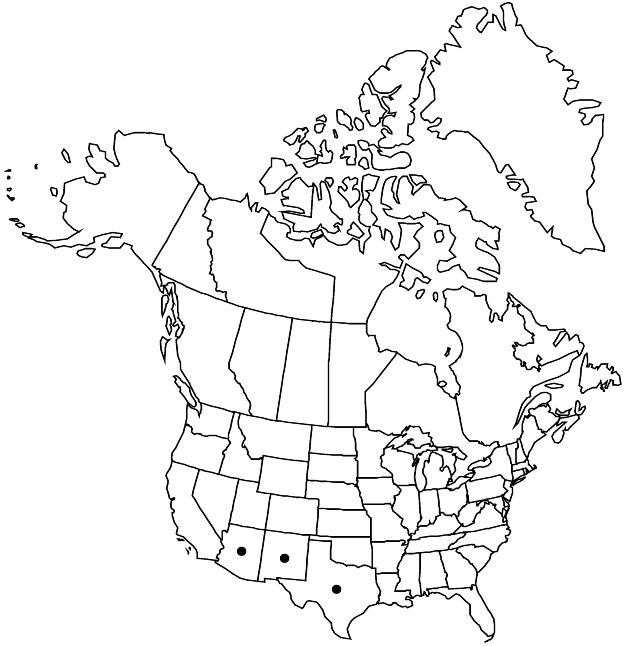Eriogonum abertianum
in W. H. Emory, Not. Milit. Reconn., 150. 1848.
Herbs, erect or spreading, annual, 0.5–6 (–7) dm, hirsute, greenish, grayish, tawny, or reddish. Stems: caudex absent; aerial flowering-stems prostrate to erect, solid, not fistulose, 0.1–1 dm, appressed-hirsute. Leaves basal and cauline; basal: petiole 0.5–6 cm, villous to hoary, blade oblong to obovate, 1–4 × 1–3 cm, villous to hoary-tomentose and greenish, tawny, or reddish on both surfaces, margins plane, occasionally crenulate; cauline sessile, blade linear, lanceolate, or narrowly obovate, 1–4 × 0.3–2 cm, similar to basal blade. Inflorescences cymose, open to diffuse, 5–40 (–60) × 5–50 cm; branches hirsute; bracts 3–6, semileaflike, 2–10 × 1–3 mm. Peduncles ascending to erect, mostly straight, slender, 0.5–6 cm, villous to hoary-tomentose. Involucres broadly campanulate, 2–3 × 2–3 mm, villous-canescent; teeth 5, lobelike, usually reflexed, 4–6 mm. Flowers 3–4.5 mm; perianth white to pale-yellow in early anthesis, becoming reddish or rose, glabrous; tepals dimorphic, those of outer whorl orbiculate-cordate, those of inner whorl lanceolate to spatulate; stamens mostly exserted, 1.5–3.5 mm; filaments mostly pilose proximally. Achenes brown to dark-brown, lenticular, 0.6–1 mm, glabrous. 2n = 40.
Phenology: Flowering year-round.
Habitat: Sandy, gravelly, or clayey flats, washes, and slopes, mixed grassland, saltbush, greasewood, creosote bush, blackbrush, and manzanita communities, oak and conifer woodlands
Elevation: 400-2500 m
Distribution

Ariz., N.Mex., Tex., Mexico (Coahuila), Mexico (Chihuahua), Mexico (Sonora), Mexico (San Luis Potosí)
Discussion
Eriogonum abertianum is widespread and common to abundant or even locally weedy. It is basically a species of the Chihuahuan and Sonoran deserts, ranging from San Luis Potosí and Sonora in northern Mexico to western Texas and much of New Mexico and Arizona.
This species is exceedingly variable and can be differentiated into several geographic and seasonal phases (C. C. Baskin et al. 1993; G. A. Fox 1989, 1990, 1990b). Variety abertianum (including E. pinetorum) is a more northern and western, summer- and fall-flowering expression, with an erect habit and a cymose-paniculate inflorescence when the plants are in fruit. A vernal phase (var. villosum) of this northern form occurs throughout much of the same range (mainly Arizona, New Mexico, and the Sonoran Desert of Mexico). It is a hairier and more spreading expression, with elongated inflorescence branches bearing more floriferous involucres. Variety ruberrimum (including E. cyclosepalum) is the more southern, summer- to fall-flowering expression (mainly New Mexico, Texas, and the Chihuahuan Desert of Mexico) with a prostrate to spreading, compact habit and a racemose inflorescence at full maturity. There is a vernal expression of this as well; it differs from the vernal form of var. abertianum in having longer peduncles. There are no sharp morphologic or geographic boundaries for any of these expressions, and while the fruiting extremes are clearly distinguishable, far too many specimens are impossible to place satisfactorily.
The Navajo (Diné) people use these plants as a lotion for both themselves and their horses (P. A. Vestal 1952).
Selected References
None.
Lower Taxa
"dm" is not declared as a valid unit of measurement for this property."dm" is not declared as a valid unit of measurement for this property.
